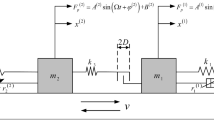The geometry and kinematics of a dynamic system with several degrees of freedom and controllable friction clutches are considered. The necessary kinematic transmission ratio between the input and output links is obtained using the friction clutches. The model uses a smooth approximation of the discontinuous function of the moment of friction. This allows continuous numerical integration of the equations of motion without changing their structure, i.e., preserving their number. The switching from one speed of rotation of the output link to another is controlled by specifying time functions that implement the pressure of the clutch discs. An example of a numerical study of such a mechanism consisting of three differentials and four clutches is considered. Dynamic processes for this system are analyzed.
Similar content being viewed by others
References
D. R. Bukhgol’ts, A Course of Theoretical Mechanics [In Russian], Vol. 2, Nauka, Moscow (1979).
Yu. N. Kirdyshev, Multiple Power Path Differential Transmissions [In Russian], Mashinostr., Leningrad (1969).
S. N. Kozhevnikov, The Dynamics of Machines with Elastic Linkage [In Russian], Izd. AN USSR, Kiev (1961).
A. F. Filippov, Differential Equations with a Discontinuous Right-Hand Side [In Russian], Nauka, Moscow (1985).
E. Ya. Antonyuk and A.T. Zabuga, “Dynamics of a two-link vehicle in an l-shaped corridor revisited,” Int. Appl. Mech., 50, No. 2, 222–230 (2014).
E. Ya. Antonyuk and A.T. Zabuga, “Motion of an articulated vehicle with two-dimensional sections subject to lateral obstacles,” Int. Appl. Mech., 52, No. 4, 404–412 (2016).
I. I. Hussein and A.M. Bloch, “Optimal control of underactuated nonholonomic mechanical systems,” IEEE Trans. Automat. Control, 53, No. 3, 668–682 (2008).
A. S. Khoroshun, “Stability of the horizontal flight of an aircraft,” Int. Appl. Mech., 52, No. 1, 96–104 (2016).
V. B. Larin and A. A. Tunik, “On problem of synthesis of control system for quadrocopter,” Int. Appl. Mech., 53, No. 3, 342–348 (2017).
A. A. Martynyuk and N. V. Nikitina, “On the quanlitative analysis of one model of transport vehicle,” Int. Appl. Mech., 54, No. 2, 231–238 (2018).
N. V. Nikitina, “Analyzing the mechanisms of loss of orbital stability in mathematical models of three-dimensional systems,” Int. Appl. Mech., 53, No. 6, 716–726 (2017).
L. A. Pars, A Treatise on Analytical Dynamics, Heinemann, London (1964).
Author information
Authors and Affiliations
Corresponding author
Additional information
Translated from Prikladnaya Mekhanika, Vol. 55, No. 2, pp. 126–132, March–April, 2019.
Rights and permissions
About this article
Cite this article
Antonyuk, E.Y., Zabuga, A.T. Mathematical Model of Speeds Change Device on the Basis of Switched Differential Mechanisms. Int Appl Mech 55, 222–228 (2019). https://doi.org/10.1007/s10778-019-00952-4
Received:
Published:
Issue Date:
DOI: https://doi.org/10.1007/s10778-019-00952-4




